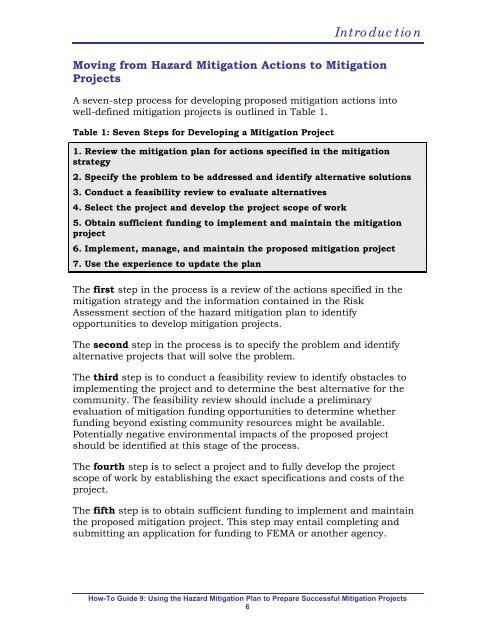Using the Hazard Mitigation Plan to Prepare Successful Mitigation ...
Using the Hazard Mitigation Plan to Prepare Successful Mitigation ...
Using the Hazard Mitigation Plan to Prepare Successful Mitigation ...
You also want an ePaper? Increase the reach of your titles
YUMPU automatically turns print PDFs into web optimized ePapers that Google loves.
Introduction<br />
Moving from <strong>Hazard</strong> <strong>Mitigation</strong> Actions <strong>to</strong> <strong>Mitigation</strong><br />
Projects<br />
A seven-step process for developing proposed mitigation actions in<strong>to</strong><br />
well-defined mitigation projects is outlined in Table 1.<br />
Table 1: Seven Steps for Developing a <strong>Mitigation</strong> Project<br />
1. Review <strong>the</strong> mitigation plan for actions specified in <strong>the</strong> mitigation<br />
strategy<br />
2. Specify <strong>the</strong> problem <strong>to</strong> be addressed and identify alternative solutions<br />
3. Conduct a feasibility review <strong>to</strong> evaluate alternatives<br />
4. Select <strong>the</strong> project and develop <strong>the</strong> project scope of work<br />
5. Obtain sufficient funding <strong>to</strong> implement and maintain <strong>the</strong> mitigation<br />
project<br />
6. Implement, manage, and maintain <strong>the</strong> proposed mitigation project<br />
7. Use <strong>the</strong> experience <strong>to</strong> update <strong>the</strong> plan<br />
The first step in <strong>the</strong> process is a review of <strong>the</strong> actions specified in <strong>the</strong><br />
mitigation strategy and <strong>the</strong> information contained in <strong>the</strong> Risk<br />
Assessment section of <strong>the</strong> hazard mitigation plan <strong>to</strong> identify<br />
opportunities <strong>to</strong> develop mitigation projects.<br />
The second step in <strong>the</strong> process is <strong>to</strong> specify <strong>the</strong> problem and identify<br />
alternative projects that will solve <strong>the</strong> problem.<br />
The third step is <strong>to</strong> conduct a feasibility review <strong>to</strong> identify obstacles <strong>to</strong><br />
implementing <strong>the</strong> project and <strong>to</strong> determine <strong>the</strong> best alternative for <strong>the</strong><br />
community. The feasibility review should include a preliminary<br />
evaluation of mitigation funding opportunities <strong>to</strong> determine whe<strong>the</strong>r<br />
funding beyond existing community resources might be available.<br />
Potentially negative environmental impacts of <strong>the</strong> proposed project<br />
should be identified at this stage of <strong>the</strong> process.<br />
The fourth step is <strong>to</strong> select a project and <strong>to</strong> fully develop <strong>the</strong> project<br />
scope of work by establishing <strong>the</strong> exact specifications and costs of <strong>the</strong><br />
project.<br />
The fifth step is <strong>to</strong> obtain sufficient funding <strong>to</strong> implement and maintain<br />
<strong>the</strong> proposed mitigation project. This step may entail completing and<br />
submitting an application for funding <strong>to</strong> FEMA or ano<strong>the</strong>r agency.<br />
How-To Guide 9: <strong>Using</strong> <strong>the</strong> <strong>Hazard</strong> <strong>Mitigation</strong> <strong>Plan</strong> <strong>to</strong> <strong>Prepare</strong> <strong>Successful</strong> <strong>Mitigation</strong> Projects<br />
6

















